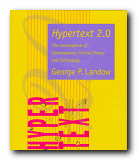essays on literature and literary theory in the digital age
George Landow was amongst the early few to spot the similarities between modern literary theory and the technological possibilities of hypertext programmes. This is the third of his publications which explore connexions between them. The general argument he makes is that the digitization of text coupled with the associative links of hypertext represents a development of revolutionary potential.
 It makes new literary forms available, blurs distinctions between existing genres [‘boundary erasure’] and makes possible anything from multimedia compilations started by authors but completed by their readers, to texts which are ‘unreproducible’ because of their size and their constant revision.
It makes new literary forms available, blurs distinctions between existing genres [‘boundary erasure’] and makes possible anything from multimedia compilations started by authors but completed by their readers, to texts which are ‘unreproducible’ because of their size and their constant revision.
His introductory essay is an invigorating mixture of reports on hypertext projects and visionary ideas of the kind promoted by Jay Bolter and Nicholas Negroponte. Unfortunately, his fellow contributors fail to match his standard. The other essays deal with non-linearity as one of the essential features of hypertext, the politics of this branch of IT, and what promotes itself as new writing – ‘hypertext fiction’, a somewhat dubious notion over which there is still much debate.
They range enthusiastically over topics as diverse as Wittgenstein’s notebooks, films and narratology, and forms of classical rhetoric. But much of their exposition is clogged with silly jargon [‘texton’, ‘scripton’, ‘screener’] which is depressingly rife amidst professionals in the field of cultural studies.
At their worst the essays deal in speculation rather than reporting
on practical experiences or successful projects. Mireille Rosello for instance at one point drops to the level of conceptual art when she spends two or three pages describing what an imaginary hypertext programme could be like. Since there are unsung technical writers out there in the field constructing hypertext programmes for real right now, this is a feeble and self-indulgent substitute. There are just too many questions raised, not enough empirical data or answers.
One further dispiriting feature is the tendency of the authors to draw on the same material, and even worse to quote each other. It is one thing for them to [quite understandably] cite Ted Nelson as a hypertext visionary, but when yet another reference to Thomas Pynchon occurs in the fourth or fifth essay, one wonders if these aren’t the papers of some post-graduate club. This suspicion is reinforced by the tendency for them all to quote from the same fashionable cultural theorists – Deleuze, Guattari, Baudrillard, and Lyotard. The collection ends with a piece of post-Modernist tosh by Gregory L Ulmar which weaves a tissue of non-sequiturs around a contrived verbal connection between Wittgenstein [again] and Carmen Miranda.
In Landow’s own survey of current programmes and projects [written, one supposes, circa 1993/94] it is interesting to note how often he describes the hypertext systems available by using the telling metaphor of a ‘web’ of connexions. The World Wide Web which was under development at that very time now makes available many of the linkages dreamed of from Vannevar Bush onwards. And most importantly, they are available not merely for some technological elite as in the past, but for whoever wishes to use them. This is a democratizing influence which will have a profound effect upon the construction, assembly, and cross-linking of information – and Landow knows it. One of the driving forces behind this collection of essays is to make these possibilities known. I imagine that a further post-WWW volume is on its way right now – but I hope he writes the book himself.
© Roy Johnson 2000
George P. Landow, (ed) Hyper/Text/Theory, Baltimore and London: Johns Hopkins University Press, 1994, pp.379, ISBN: 0801848385
More on literature
More on the novella
More on literary studies
More on short stories